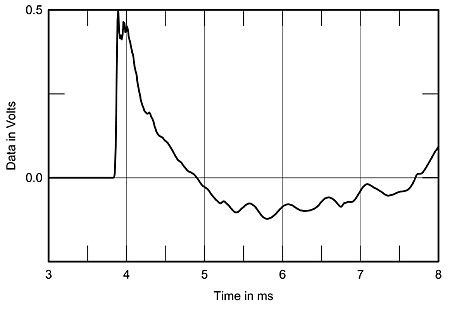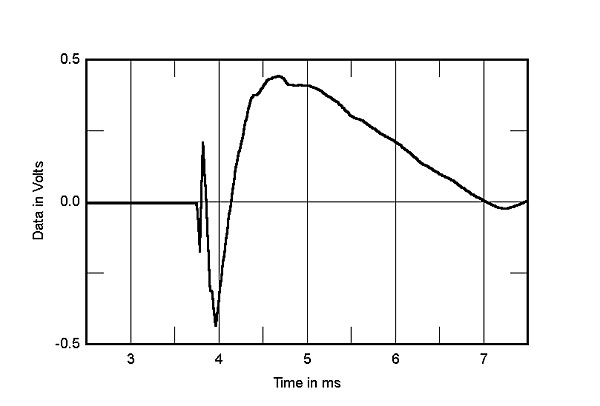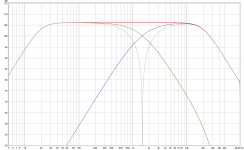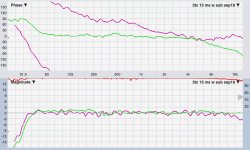...A question: If a tweeter and mid-woofer and time aligned beforehand, should they both be wired in the same polarity, or should the tweeter be wired with opposite polarity (like conventional non-time aligned speakers)?
If you want transient perfect behavour then my understanding is from John Kreskovsky posts that yes always wire polarity the same, but depending what acoustic slope is chosen and whether target is minimum or linear phase system 2nd order acoustic slope is example where for minimum phase we want polarity reversed else XO region is always 180º apart and cansel out, where if 2nd order acoustic slope is linear phase polarity should be same. Synthetic simulation example below is 2nd order LR slope at 1,5khz inside a 20Hz-20kHz system pass-band, example is created using free Rephase to spit out band-pass impulse wav-files that is imported to free REW and manipulated in time and math available in "All SPL"/"Impulse" tab, can recommend use those two tools to exercise whatever minimum phase or linear phase slopes can do when summed and how polarity would look.
Attachments
While i't's one thing to create a linear phase speaker, it won't help you much once you place it inside your room. Unless you tailor your room to perceive that linear phase wave front at the listening spot.
That's what Mitch has in his example, that's what makes a difference. The linear phase speakers that are mentioned are one thing, but if the room does not play along the actual perceived wave front won't be linear anymore.
That's what Mitch has in his example, that's what makes a difference. The linear phase speakers that are mentioned are one thing, but if the room does not play along the actual perceived wave front won't be linear anymore.
This response was done with a speaker (my old "CoSynes") that has the tweeter phase inverted.


All speaker drivers are highpass or bandpass, and physical delay and all-pass networks can make them behave in limited frequency ranges as if there were another inversion. If we used a response down to DC then absolute wireing polarity might be required. And of course an FIR equalizer can do pretty much anything.
All speaker drivers are highpass or bandpass, and physical delay and all-pass networks can make them behave in limited frequency ranges as if there were another inversion. If we used a response down to DC then absolute wireing polarity might be required. And of course an FIR equalizer can do pretty much anything.
Attachments
Last edited:
While it's one thing to create a linear phase speaker, it won't help you much once you place it inside your room.
I'll second that. You should to draw a picture of your "control volume" that includes your room, loudspeakers, their placement within the room, and listeners...then assess what has to occur to hear the benefits.
Nearfield in-room effects and early reflections usually negate all the linear phase efforts. If you have a relatively live listening room with insufficient near field absorption down to at least the transition frequency, you're going to wind up largely masking the effects of the linear phase loudspeakers in-room, IME.
This also includes the source music--which I find is typically nowhere close to linear phase from the mastering engineer's DAW output. You must first look closely at what you're playing--and if it's been significantly EQed (as most recordings are), it will strongly benefit by de-EQing due to its minimum phase nature, to return the recordings' phase back much closer to "linear phase before mastering".
Chris
Last edited:
While i't's one thing to create a linear phase speaker, it won't help you much once you place it inside your room. Unless you tailor your room to perceive that linear phase wave front at the listening spot.
That's what Mitch has in his example, that's what makes a difference. The linear phase speakers that are mentioned are one thing, but if the room does not play along the actual perceived wave front won't be linear anymore.
i´ve done best i could.
theres midbass horn on the floor and i cross upper midrange horn just before floor bounce kicks in.
bwaslos phase looks good. i had bit better phase curve too when i had direct radiating speakers involved.
these horns tend to bend some phase
and because of upper midrange phase distorion my time aligment isnt 100%.
they are physically on same line but theres 28cm delay for upper mid, causes little bit of pre-rise to step response but sure do sound better than jagged phase curve
Last edited:
Thanks for the replies, guys.
I set the current speakers up by ear only. The placement of the left channel is about 20% along the front wall and the right is a mirror of the left. I modeled the room for the first time this summer and the placement I found sounded best was also what REW predicted as the best position within about 0.25". I added 6 sqft of 3" thick broad-band studio panels and will be adding more.
I'm building a new house soon and the media room dimensions are not finalized yet. Maybe linear phase is a fruitless task?
I'll make an effort to bring the dimensions here.I'll second that. You should to draw a picture of your "control volume" that includes your room, loudspeakers, their placement within the room, and listeners...then assess what has to occur to hear the benefits.
I set the current speakers up by ear only. The placement of the left channel is about 20% along the front wall and the right is a mirror of the left. I modeled the room for the first time this summer and the placement I found sounded best was also what REW predicted as the best position within about 0.25". I added 6 sqft of 3" thick broad-band studio panels and will be adding more.
I'm building a new house soon and the media room dimensions are not finalized yet. Maybe linear phase is a fruitless task?
Thank you. That does sound a bit involved and totally new to me. How does a person determine the phase or EQ nature of recordings?Cask05 said:This also includes the source music--which I find is typically nowhere close to linear phase from the mastering engineer's DAW output. You must first look closely at what you're playing--and if it's been significantly EQed (as most recordings are), it will strongly benefit by de-EQing due to its minimum phase nature, to return the recordings' phase back much closer to "linear phase before mastering".
Chris
Maybe linear phase is a fruitless task?
I wouldn't say that--it's just that as you get further down the path toward the music reproduction fidelity, the low-hanging fruit is gone and the higher-up fruit requires a bit more effort...that's all.
How does a person determine the phase or EQ nature of recordings?
See the pdf tutorial files here. Since recordings are minimum phase, when you correct the frequency response imposed by mastering, you also correct phase. [However, phase errors introduced via recording and mixing processes are basically not correctable. You can hear those recording and mixing mistakes when you start to demaster recordings.]
Chris
Last edited:
I wouldn't say that--it's just that as you get further down the path toward the music reproduction fidelity, the low-hanging fruit is gone and the higher-up fruit requires a bit more effort...that's all.
Chris
There is somebody jumping to a lot of conclusions about why records sound the the way they do, and have whatever frequency spectrum they do.
If someone likes a particular type of frequency spectrum to enjoy music on their system and wants to use EQ to get it, fine. But, don't pretend it's de-mastering.
Perhaps consider that musical instruments often do not fit together to produce the most musical sound since performances and technique used by particular players on particular instruments, in particular recording spaces, and as picked up with particular microphones all affect what must then be mixed. What's done is usually not damage, and very few people would want to listen to muddy sounding records if it weren't done.
As far as rolled off bass, music recordings have to be produced to play back on a wide variety of playback systems. Some systems have extremely accentuated bass, such as those with tightly fitted earbuds. Other have rather weak bass. By a variety of means bass and harmonics of bass fundamentals are managed to arrive at something that can sound decent on most systems.
On some systems, way more bass would sound good, but records can't be made to sound good only on one type of system, and unfortunately there is no standardization for playback system performance. I have reluctantly had to cut bass in mastering even though it might have sounded better with more bass on many systems. Why? Basically, because of earbuds and car radios.
Anyway, anybody can add all the EQ they want to make their system or records sound the way they prefer. But, please don't pretend you are fixing things that the artist and the record label didn't intend and didn't approve of.
EDIT: Much mastering of CDs and other media types is now done with linear phase EQs, just so everyone is aware of that.
Last edited:
Currently, my demastering total is about 11000 music tracks. The reason why I mentioned the demastering method above...is because it works, and works quite well.
Okay, not saying what you're doing is bad. It just seems like the process as described is mis-named. There is more to mastering than applying EQ, and de-mastering would have to alter more than just EQ in virtually all cases to literally constitute de-mastering.
Also, the website link for more information on the process appears to attribute motivation for some things that mastering engineers are hired to do, such as increase apparent loudness, as though those things are done with disregard for the original purity of the natural sound. Fact is, most mastering engineers don't like the loudness wars any more than you do. These days, its artists and record companies that insist on loud masters. If one engineer can't or won't do it, they will find one who will.
In addition, often artists and record labels don't necessarily value the purity of natural sound over what they consider to be good, commercial sound that can sell lots of records. Of course, if they think natural sound will sell the most records, then fine, natural is good.
Otherwise if record buyers are going for loud, bright, and distorted records, then that is what will be made. Apparently some buyers don't find those types of thing to be damage, and they may even think the presence of such sound characteristics increases the emotional impact of the music, not worsens it.
Last edited:
Hi Art,
The first is what I know as "time co-incident." That is, the starting edge of all drivers is in the same place in time. As Bill Waslo points out often, it only works in 1 point in space unless you are using a co-axial speaker. Move vertically off axis and it's gone.
Look at the impulse of this Vandersteen model seven which is time-coincident. All three drivers start at the same time and create a single triangular impulse:

Vs. this one from a Monitor Audio Platinum II which is not (but still a very good speaker). You can see the three drivers start at different times and they do not create a single impulse.
The tweeter starts downwards and ahead of the midrange, which is also going downwards, followed finally by the positive large, broad and slow woofer:

Also please note that having a stepped baffle is no guarantee of time-coincident but it is often required.
Using a stepped baffle can solve issues around number of crossover poles used to achieve perfect phase alignment (not the same thing, any commercial speaker should have good phase alignment) but is no guarantee of a coincident leading edge.
Credits for both images go to Stereophile.
it seems to me you are mistaking step response with impulse response eriksquires
While i't's one thing to create a linear phase speaker, it won't help you much once you place it inside your room. Unless you tailor your room to perceive that linear phase wave front at the listening spot.
That's what Mitch has in his example, that's what makes a difference. The linear phase speakers that are mentioned are one thing, but if the room does not play along the actual perceived wave front won't be linear anymore.
Hi Ron, I like to think of it a little differently...
I like to think that any speaker placed in room gives a summation of the speaker and the room reflections.
If I start with a linear-phase speaker that also has flat frequency response, I know that once in a room, any response deviations from flat phase and frequency response, is due to room reflections.
So I know to work on speaker placement and acoustic treatments, because the variations are an acoustical issue, not a speaker issue.
For me using EQ or DSP to solve acoustical issues is the last resort....and is really reserved for one-spot listening IMHO.
In my mind, start with the best speaker you can, which includes at least smooth phase, if not linear phase.
IME, If the room is halfway decent, measurements don't deteriorate too much. If measurements do change alot, save yourself some aggravation and get a new room haha.
I really do believe the biggest mistake in home audio is trying to tune speakers and room together without dissecting what's doing what.
It's just too difficult to know what you can and can't fix electrically, unless you're a tuner happy with tuning to one spot level.
I'd like to add, I can easily say achieving linear phase outdoors has made indoor tuning so much easier, and has without a doubt made my best sound both outdoors and in.
Hi Mark,
That's not a bad way to view things . Anyway you look at it, the room is best fixed with acoustic treatment and not DSP. The speaker design can help you make life easier.
. Anyway you look at it, the room is best fixed with acoustic treatment and not DSP. The speaker design can help you make life easier.
To judge anything worthwhile, one should look at what happens at that listening spot or area.
That's not a bad way to view things
To judge anything worthwhile, one should look at what happens at that listening spot or area.
How are time/impulse aligned and linear phase accomplished in the same loudspeaker?
Hi Art, here's my FWIW take.....
Time aligned means drivers' phase traces lay on top of each other, though the frequencies of acoustic summation (xover region), which makes for a smooth flowing combined trace.
The traces don't have to be flat to have time alignment, in fact traces are seldom ever flat unless they are also ....
......Linear phase ...which means just that, the phase traces are lines, most often thought of as horizontal.
When phase traces overlap (whether linear or not), the initial rise of any frequency's wave within the xover region, occurs at the same time for both drivers, ........but only on an individual frequency by freq basis.
IMO, this equals time alignment as is commonly thought of.
This is not to say all frequencies within the xover region have the same initial rise time. If that were the case then you have the added the condition of linear phase.
This is what what makes linear phase so desirable....... not only are drivers time aligned frequency by freq through their handshake region, but also ALL frequencies in the handshake share the same initial rise time.
And if linear phase extends past handshakes and though all the drivers responses, then all frequencies low to high are timed together with the same initial rise time, and a rare time coherency has occurred.
Below are 2 examples of the same 4-way system, with a sloped phase and a linear phase, trying to picture the above statements:
The purple trace is time aligned fairly well, because there is pretty decent continuity in the overall phase trace.
Whereas the green trace is both time-aligned and linear phase.
(Pls ignore phase slope beyond 6kHz.. a little wind makes mic move enough to float phase tail up and down)
Again, all FWIW.
Attachments
Last edited:
Hi Art, here's my FWIW take.....
Time aligned means drivers' phase traces lay on top of each other, though the frequencies of acoustic summation (xover region), which makes for a smooth flowing combined trace.
The traces don't have to be flat to have time alignment, in fact traces are seldom ever flat unless they are also ....
......Linear phase ...which means just that, the phase traces are lines, most often thought of as horizontal.
When phase traces overlap (whether linear or not), the initial rise of any frequency's wave within the xover region, occurs at the same time for both drivers, ........but only on an individual frequency by freq basis.
IMO, this equals time alignment as is commonly thought of.
This is not to say all frequencies within the xover region have the same initial rise time. If that were the case then you have the added the condition of linear phase.
100% agreed! This is the best explanation given in this thread so far.
Marco
Linear phase EQ is not something that occurs in nature.
However, with FIR digital filters is possible to do. How? By passing the signal forward and backwards in time, so phase shifts cancel out.
For example, there is a way to pretty much the same thing with a tape recorder and some time. Take a signal and record it to tape while applying half of the desired EQ magnitude. Then flip the tape over so that it plays backwards in through the tape machine, then play it back and apply the other half of the EQ. Phase shifts cancel out since if phase shift was lagging on the first pass, on the second backwards pass it will be leading, and thus on the second EQ pass, the net total EQ has been applied with no resulting phase shift due to the cancellation.
In a digital FIR filter the same type of thing can be done, but just as with using a physical tape machine some latency is added due to the processing backwards and forward through time.
For loudspeaker crossovers, depending on the cross over filter types and processing latency, the signals for different drivers may now be out of time with each other. That can be fixed by delaying the signal that is most ahead in time so that it matches the timing of the other signal. Now the signals are time aligned.
However, with FIR digital filters is possible to do. How? By passing the signal forward and backwards in time, so phase shifts cancel out.
For example, there is a way to pretty much the same thing with a tape recorder and some time. Take a signal and record it to tape while applying half of the desired EQ magnitude. Then flip the tape over so that it plays backwards in through the tape machine, then play it back and apply the other half of the EQ. Phase shifts cancel out since if phase shift was lagging on the first pass, on the second backwards pass it will be leading, and thus on the second EQ pass, the net total EQ has been applied with no resulting phase shift due to the cancellation.
In a digital FIR filter the same type of thing can be done, but just as with using a physical tape machine some latency is added due to the processing backwards and forward through time.
For loudspeaker crossovers, depending on the cross over filter types and processing latency, the signals for different drivers may now be out of time with each other. That can be fixed by delaying the signal that is most ahead in time so that it matches the timing of the other signal. Now the signals are time aligned.
Last edited:
All this information was very helpful. The two questions I have to answer myself are: (1)will the drivers will be offset for alignment or let an active device handle the task, and (2) will linear phase or minimum phase crossovers be used. Latency could be an issue since my system is also used for video.
- Status
- This old topic is closed. If you want to reopen this topic, contact a moderator using the "Report Post" button.
- Home
- Loudspeakers
- Multi-Way
- Explanation of Time Aligned and Linear-Phase?



